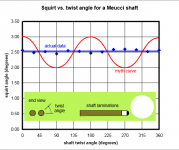You and the chart from the empirical testing are correct. with the 35 layers oriented up and down and the black dot pointing up or zero or 180 degrees, the squirt was less than when the cue was rotated 90 or 270 degrees by about 5%. or more than Dave's aforementioned 1.5%.
Obviously the front end mass is the same regardless of orientation, but the stiffness is less at 0 and 90 degrees - almost insignificant so it seems except for a couple of scientists who wrote studies on this subject.
Cornerman mused that a shaft shaped like an "I" beam or a rectangular cross section would be lighter (less mass) than the ubiquitous round shape ergo less squirt and would yield similar results when rotated,
The ferrule would need some gusseting to be stable during several impacts.
Like Meucci, there could be a black dot atop the "I" beam like dotting the "I". :smile:
View attachment 410183
E,
For thought purposes only, forget the "I" beam, as the top & bottom have a stabilizing effect in that direction.
Just take the center piece out of the 35 laminations & then saw a slot down the middle of a slip on ferrule/tip or the like & attach it to the end.
Then hit the ball with the 'height' running up & down vs running sideways while hitting exactly on the equator of the ball with "it" perfectly level.
As you say the front end mass, or weight, is exactly the same.
Now what parameter has the most effect on squirt? "Front end mass" or FLEX?
It's the same shaped 'cue' with the same front end mass just in a different orientation regarding it's flex properties.
So...
the delivery method of the 'front end mass', even by the same piece of wood (plastic might be better), is different &
hence...
the
effective front end mass would be vastly different.
I realize that this is not exactly how a round normal piece of wood would act given the taper, etc. It's just for visual & thought purposes.
The thing is that there are some that do not not like 'weak' whippy shafts. So, reducing the front end mass is probably the proper solution for them.
Then there are those that do not like the 'hollowness' of some of the LD shafts so for them adding flex may be the proper solution for them.
The thing is that up to now I do not think a shaft manufacturer has gone with a combination of both. They have gone in one direction or the other, but not both at the same time.
Golf Clubs were not too too long ago made of wood & forged steel. Then the casting process opened up a whole other realm of design capabilities.
Now club heads are made of multiple metals along with polymers. Tennis rackets were all wood, then steel, now fiberglass, graphite, & other materials. it's the same thing for baseball bats at the non Pro Level.
I don't think there is as much that can be done for pool & many good players have been quite capable of making the allowances for squirt & swerve but I can certainly see some young player coming out one day with a super high tech pool cue that is not made of wood or at least not entirely.
Back in the day who was thinking about reducing squirt but Bob Meucci? Today who but Bob Meucci is thinking about the effect that the butt of the cue might have & who else is using what I think is a patented plastic.
How about a hollow Plastic (liquid) tube with a cross diameter support with a slot cut out of the perimeter length at 90* to the diameter support but only on one(1) side?
Just food for thought.
Best 2 Ya & Stay Well, E.
PS there was a very fexibile fiberglass golf shaft that I think was called FiberSpeed. It was supposed to be able to 'recover' regardless of what speed the club was swung, form a weaker lady to a male pro. I think it worked but too many just did not like the whippy feel of it so it died a rather quick death.
